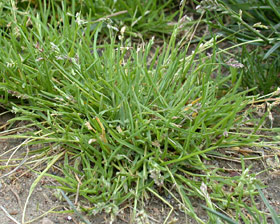Annual Bluegrass, Poa annua

Photo from UMass Amherst Landscape, Nursery, and Urban Forestry Program.
IPM Steps to Reduce Annual Bluegrass
1. Sample for Pest
Confirm the presence of annual bluegrass before you treat.
Where to find it while inspecting: You will find annual bluegrass in almost all turf and is not always considered a weed. In summer heat it goes yellow during dormancy. Look for seedheads throughout the season.
2. Proper ID
Is it annual bluegrass?
Size and Appearance: Usually small “soft” clumps, light green narrow blades (generally 1.5" long and 1/8" wide). Smooth blades with “keel-shaped” tips. The seed heads are not on stalks but are flattened panicles (panicle, cone-shaped, open, light green to white, branched spikelets). Often with short wrinkled segment mid-blade, folded in bud; auricles absent; ligule membranous, white, peaked; sheaths smooth, compressed.
3. Learn the Pest Biology
What is the life cycle of annual bluegrass?
Life Cycle: An annual that produces seeds throughout the growing season and then dies. Seeds sprout the next spring.
Preferred Habitat: Annual bluegrass is common in most turf and often tolerated as a lawn grass, so prefers full sun to light shade, moist conditions and loamy soil.
4. Determine Threshold
How much (annual bluegrass) is too much?
5. Choose Tactics
Creating a healthy soil condition and understanding turfgrass’s needs is the first step in reducing turf pests. What can I do to treat, reduce, or prevent annual bluegrass?
Best Management Practices: Maintain proper soil pH: 6.0 to 6.8 (test every 3–5 years). Fertilize at the proper time for turfgrass root development, primarily fall (late spring at times when turf is weak and thin), irrigate if needed, mow at proper height (removing no more than 1/2 of the blade), amend poor soil, choose proper turfgrass seed for your conditions, buy quality seed, overseed thin spots in fall or early spring, remove thatch.
6. Evaluate
Was the tactic successful? Record the date pests were first noted, and the tactic you used, and its success. Use one of our RECORD KEEPING tools.
Remember:
When a pesticide application is necessary, all necessary and required precautions are taken to minimize risk to people and the environment and to minimize risk of pesticide resistance or pest resurgence. Pesticide use in your school may be prohibited or regulated by local policies or state and federal regulations. Risk reduction methods can include, but are not limited to, spot-treatment, the use of gel or paste bait formulations placed in inaccessible locations, injection into a crack or crevice, and other methods that reduce potential exposure.